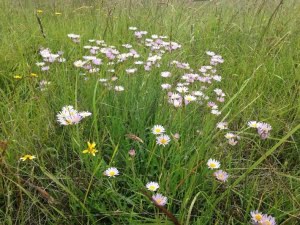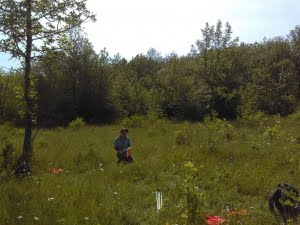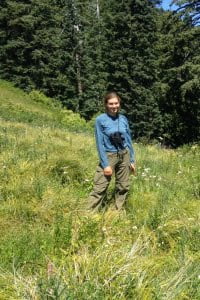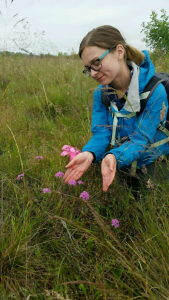
In search of Willamette Daisy!
By Marisa Mancillas, Jillian Demus, Chelsea Osbron, and Amy Zimmer
August 2018
This field season, IAE’s Habitat Restoration and Conservation Research Programs partnered to conduct a range-wide inventory of the endangered Willamette daisy (Erigeron decumbens). The goal of this project was to obtain an up-to-date status of this endemic plant and its associated habitat quality in the Willamette Valley of Oregon, enabling local land managers and property owners to make informed decisions regarding conservation and restoration. A lack of rain in May accelerated our field schedule a bit, but thanks to our hard working crew and some collaboration with partners, we were able to visit 73 of 82 known patches, from the wetlands of west Eugene to the dry upland prairies north of Salem.


The results of our surveys confirm what many at IAE and elsewhere have long known – the Willamette daisy is a vulnerable species whose extent is diminishing. In over 30% (24 out of 73) of the patches we surveyed, the plant was extirpated (no longer present). However, many of the patches we visited ranged in size from hundreds to thousands of plants and are on protected public lands. We also had the pleasure of working with several private land owners who were very interested in not only helping us relocate the daisy on their property, but also managing their lands so the daisy may persist there.
IAE continues to dedicate resources to the conservation of the Willamette daisy and several other rare species by growing and outplanting young plants at restoration sites, researching effective treatments to improve habitat quality, and conducting surveys such as this one.
Meet the Crew!
Marisa Mancillas
I’ve always been drawn towards plants. As a preteen I’d escape to the oak woodland, wander all day feeling overwhelmed by the ecology. The way plants organize themselves on the landscape. How fleeting a wildflower bloom is. How plants arrange themselves according to sun, slope, soil, and space. I would have been amazed to know that I’d grow up to observe these phenomena every day for a living. That’s how I feel at work: overwhelmed by the ecology and amazed that my passion and work align.
The Willamette Valley prairies of western Oregon feel particularly meaningful. This season, my crew and I have been monitoring populations of Willamette daisy (Erigeron decumbens). This daisy wasn’t observed for over 40 years and was presumed to be extinct from 1934 to 1980. As a plant person, I sometimes get lost in the details, but the big picture is that the United States changed rapidly in the 20th and 21st centuries. Everyone, and everything was effected, including the ecology of western Oregon, leaving the Willamette Valley prairies reduced to less than 1% of its original extent. Before the colonization of the Indigenous peoples of Oregon, the prairie ecosystems were burned frequently to keep woody vegetation from encroaching. The loss of fire as a key ecosystem process, compounded with urbanization and agriculture, has left the Willamette Valley prairies and Willamette daisy struggling to survive.


Jillian Demus
Our crew began this season monitoring nectar species for the Fender’s blue butterfly. I was amazed my first day, being able to work in a peaceful, hilly prairie with multiple swaths of beautiful plants, while also happening upon and startling a meadowlark or a turkey and her chicks. Menzies’ larkspur (Delphinium menziesii) is my favorite plant in our prairies. They are a rich, velvety purple, resembling squishy, silky moths dancing in the breeze. At one field site, Columbian larkspur (Delphinium trolliifolium) was seen in the large oak forest beyond the prairie. It was a magical sight to see the contrast of the two ecosystems with that connection of delphiniums. Despite their beauty, they are deathly toxic containing the poison delphinine. One can use the seeds externally for head lice and scabies, as it is poisonous to other critters too! I have made many other connections to other plants along the way, such as the Willamette daisy (Erigeron decumbens), in which we count every day. It feels amazing to help protect this rare species and causes me to appreciate how tough plants can be in this forever changing world. I have more than ever connected to prairies, especially because of my new love for graminoids, thanks to our crew lead, Marisa. I haven’t had a botany monitoring position before, and I have never felt so happy to be at work.
Chelsea Osbron
This summer I am lucky enough to be a botany intern at IAE, and have thus been able to spend my time surveying plants in the beautiful Willamette Valley. While most of the season we have been working with the endangered Willamette daisy (Erigeron decumbens), my favorite native plant we’ve encountered has been the narrowleaf onion, which is a nectar species for the Fender’s blue butterfly. Known also by its scientific name, Allium amplectens, this perennial forb is a member of the Amaryllidaceae family and, like me, is native to the west coast of North America. Morphologically, the flowers are white to light pink in color, have upturned tepals, and appear in clusters of 10-50 at the tip of a 15-30 cm stem.
The first time I really noticed and appreciated Allium amplectens was at a site in Eugene where it had been introduced and, therefore, was present in mass quantity. As I looked over the site, I was taken aback by how much it looked like a field of light pink, onion flavored sprinkles. Prior to this moment, I had only ever seen a few individuals at a time, so I was naturally surprised by the large population in front of me and delighted by the similarity that it had to Funfetti. While we censused nectar species that day, I was reminded how fortunate I am to be able to hang out with and learn more about native plants, and I look forward to using my new knowledge and skills to explore nature more as time goes on.


Amy Zimmer
I originally heard of the Institute for Applied Ecology via an Oregon Public Broadcasting (OPB) program. Never in my wildest dreams did I imagine working as an intern for this very agency just a few short years later. The program showcased IAE’s annual Invasive Species Cookoff, and my initial impression was one of intrigue and curiosity. Upon graduating from Oregon State University in the December of 2017 with my B.S in Environmental Science, I was unsure of just what to do with my degree and specifically, where to go next. It was at this time I saw an opening for a summer internship position with IAE and thought “go for it”, and I am so happy I did. Working with IAE as a member of the Willamette Daisy (Erigeron decumbens) monitoring crew has been an amazing experience providing me with the opportunity to explore the valley that I have always called home through a different lens, uncovering rare and endangered species that have always been under my nose without even knowing it. I am forever grateful for this experience and look forward to discovering more of such places and species using the knowledge gained during my time as an intern.
While spending long days in the field, naturally one’s eye begins to develop an affinity for a particular species amongst the sea of vegetation comprising each site. For myself, for reasons unknown to me, my eye quickly began to pick out the rose checker mallow (Sidalcea virgata). While merely one of the many species encountered so far this season, I have to say the rose checker mallow, or sidalcea for short, is one of the many species and experiences I will not soon forget during my time as an IAE field member.
Tags:
Restoration
Research
Education
Contact
Main Office:
4950 SW Hout Street
Corvallis, OR 97333-9598
541-753-3099
info@appliedeco.org
Southwest Office:
1202 Parkway Dr. Suite B
Santa Fe, NM 87507
(505) 490-4910
swprogram@appliedeco.org
© 2025 Institute for Applied Ecology | Privacy Policy
